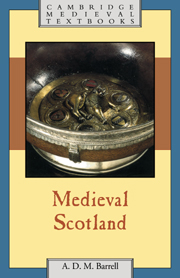Book contents
- Frontmatter
- Contents
- List of figures
- Preface
- List of abbreviations
- Maps
- 1 Early medieval Scotland
- 2 Feudal Scotland
- 3 The transformation of the Scottish church
- 4 The consolidation of the Scottish realm
- 5 The Wars of Independence
- 6 The Stewart kings
- 7 Crown and nobility in later medieval Scotland
- 8 The road to Reformation
- Conclusion
- Select bibliography
- Index
- Title in the Series
5 - The Wars of Independence
Published online by Cambridge University Press: 05 June 2012
- Frontmatter
- Contents
- List of figures
- Preface
- List of abbreviations
- Maps
- 1 Early medieval Scotland
- 2 Feudal Scotland
- 3 The transformation of the Scottish church
- 4 The consolidation of the Scottish realm
- 5 The Wars of Independence
- 6 The Stewart kings
- 7 Crown and nobility in later medieval Scotland
- 8 The road to Reformation
- Conclusion
- Select bibliography
- Index
- Title in the Series
Summary
The death of Alexander III ushered in a period of crisis for Scotland, during which the English kings involved themselves in Scottish affairs on an unprecedented scale and there was a serious danger that Scotland would cease to be an independent realm. The establishment of institutions of government which could function even in the absence of a monarch and the sense of nationhood described in the Declaration of Arbroath were, or at least became, marks of Scottish identity and pride, and the long period of resistance to English imperialism has served as a watershed in the history of medieval Scotland. In the popular mind, the age of William Wallace and Robert Bruce is one of heroes and villains, patriots and traitors, victories won against overwhelming odds. No period in Scottish history has aroused so much passion or, it must be said, so many misconceptions.
The conflict with England which began in 1296 has traditionally been regarded as a war for Scottish independence, and in some respects it was indeed a struggle for the right to self-determination. In other ways, however, it was a civil war within Scotland between rival claimants to the throne who were prepared to seek or reject English assistance as circumstances dictated. The king of England, Edward I, was both willing and able to take advantage of the opportunity presented to him by the extinction of the direct line of Scottish monarchs, but it is not certain that he set out deliberately to destroy Scotland as a separate political entity and impose his own direct lordship on the whole of Britain.
- Type
- Chapter
- Information
- Medieval Scotland , pp. 92 - 136Publisher: Cambridge University PressPrint publication year: 2000



